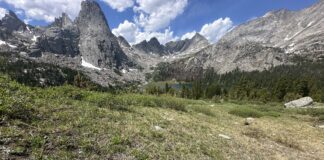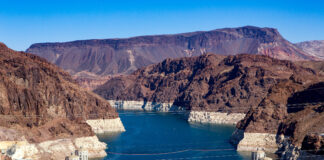
By Chris Malloy
On Navajo Nation land, a mostly rural area removed from the extravagant artificial waterways that sustain Southwestern cities, roughly two-thirds of people have access to running water. Just beyond, on the Hopi Reservation in Black Mesa, Arizona, Diné (as the Navajo call themselves) sheep herders Arvin Bedonie and Marie Gladue lack both running water and a well. Without a car and too elderly to haul water, they have to dig deep into their pockets to obtain the water they and their curly-horned sheep need to survive. The herders overpay, spending about $40 a week.
“The water itself is probably $5 at most,” Gladue said. “But to have someone haul it for you, you’re paying for their time and labor. That’s what adds up.”
Last spring, Bedonie and Gladue turned to an ancient method to help address their water travails. They began to harvest rain.

A line of 530-gallon rainwater tanks, square to better fit into a small space. Source: Lincoln Perino
Rainwater harvesting, or the collection of rain from building surfaces into vessels, might be the first way humans controlled water supply. The technology dates back at least to the dawn of agriculture. The ancients in Africa, Asia, Europe, and the Americas harvested rain. It provided water in rural Yemen, urban Rome, and Xochicalco in Mesoamerica, where rain from plazas and rooftops drained into subterranean cisterns, later used for domestic purposes or irrigation. Lacking a river, Jerusalem had cisterns that collected rain, including some carved into solid rock beneath the city.
Today, rainwater capture is used across the world. In Gansu, China, more than 10 million people have a water supply buttressed by rainwater, letting some make extra money through gardening, livestock, and poultry. In Sub-Saharan Africa, some crop yields have increased due to rainwater harvesting, according to one study. It is popular in India; in Gujarat, over a thousand schools are outfitted with rainwater catchment systems; in Tamil Nadu, all buildings must have them. More than a million homes in Australia capture rainwater. Residents of Bermuda and other islands lacking freshwater need the technology. People harvest rain in Egypt, Brazil, and Bangladesh.
Globally, rainwater harvesting can improve water access and help meet growing needs. Some 1.2 billion people lack access to safe drinking water. By 2050, the amount of food needed to feed the world is expected to double. Growing the crops to do so will take water. Though the earth looks blue from space, only three percent of our water is freshwater, and three-quarters of that is locked in glaciers (for now). That leaves about one percent of the planet’s water stock available for everyday uses like drinking, washing, and irrigation—a supply increasingly threatened as people across the globe continue to draw on aquifers and as climate change brings hotter, dryer conditions. In the American West, water has already become a pressing resource, as evidenced by the withering droughts of recent decades, and by the fact that, for instance, Arizona is already rationing its surface water supply. Rainwater harvesting—a cheap, low-barrier, low-energy method—may provide one piece of the long-term solution. It has a place in both urban and rural areas, and in developing and developed countries.
One percent of the planet’s water stock available for everyday uses like drinking, washing, and irrigation—a supply increasingly threatened as people across the globe continue to draw on aquifers and as climate change brings hotter, dryer conditions.
Most rainwater harvesting outfits look more or less like Bedonie and Gladue’s. They begin with a “catchment” surface like a roof. Rain splashes, rolls, collects, and sluices through a filter. A “roof wash” often ejects the first gallons, as these carry roof debris. Pipes or related conduits then deliver rain to storage tanks or simply the ground. From storage, water can be run to hoses, toilets, ponds, irrigation systems, herb gardens, peach trees, pet cage washing stations, even drinking glasses. With proper treatment, said Kathy Gee, professor in environmental science at Longwood University, “it’s very easy now to outfit rainwater harvesting in a way to produce potable water.”
In the United States, rainwater capture hasn’t been embraced beyond the community level due to a lack of government awareness and understanding. This is perplexing given its global reach and low-hanging benefits, like those Gladue and Bedonie enjoy (flexibility, drought hedge, access, decentralization) and others, like curbing urban flooding, stabilizing waterways during big storms, and conservation.
The potential for conservation is heartening. Rainwater harvesting could be a water source to ease mounting pressure on surface water and groundwater, by far the two biggest sources of water in the United States. This is vital given that waterways giving life to our farms and cities are stressed, like the Colorado River, and that our ancient aquifers, like the Ogallala, are diminishing. “Small changes make a big impact,” said Harold Thomas, assistant director of the Watershed Management Group in Tucson, Arizona, a city that pumps Colorado River water through more than 300 miles of desert. “The more that people use rainwater and stormwater, the less water we’re using that comes from the Colorado River and groundwater.”

In this Sept. 3, 2016 photo, Edgar Serralde, a lettuce farmer in Mexico City’s borough Xochimilco, uses a ladder to climb on to his rooftop the day a large water cistern, left, was delivered to his home. Source: AP Photo/Christian Palma
Noteworthy conservation, however, would require widespread adoption—a pipe dream in the minds of rainwater installers, educators, and enthusiasts. You could live a life in the United States without noticing rainwater capture. Even desalination and wastewater treatment are more widely known. In ignoring rainwater harvesting, the U.S. is an outlier, an improvident anomaly across borders and time.
Rainwater capture isn’t scarce in the U.S. due to legality. Today, it is legal in every state, though many have restrictions. A few, like Colorado, were late to permit the practice due to the West’s old “first in time, first in right” water rights law origins. Colorado didn’t legalize it until 2016. Even now the state’s rainwater capture laws remain draconian, limiting harvesting to 110 gallons for non-potable purposes. To sufficiently capture bigger storms, Fouad Jaber, a professor and extension specialist in integrated water resources management at Texas A&M, recommends that quarter-acre homes have systems of “at least 1,000 gallons, if not 1,500.” Some other states, like Texas and Rhode Island, encourage the practice via tax incentives. Some local governments offer their own. Tucson has two tiers of rebate, including one for up to $2,000 based on tank size.
Despite legality and safety (with the right roof materials, pipe sealing, and treatment), many factors prevent U.S. adoption. One is money. Catchment systems are cheap relative to, say, drilling 200-foot wells, but they still have costs. And these might thwart urbanites who pay less for a month of city water than for dinner out for two. “Rainwater harvesting does pay for itself,” said William Hunt, an engineer, economist, and stormwater expert at North Carolina State University. “But in our experience, you would have to own that property for decades.” More so than solar panels, how long a system takes to become profitable varies (based on roof size, annual rainfall, and collection capacity). Some studies have even found that rainwater harvesting isn’t financially feasible, period. For millions off the water grid, though, harvesting rain is priceless.
“The more that people use rainwater and stormwater, the less water we’re using that comes from the Colorado River and groundwater.”
Another obstacle to widespread adoption is that many of its benefits are nebulous and rooted in future gains. Conservation remains a long-run abstraction for some people, especially people with pressing needs today, like those in the American West piped into hard-won water systems in place for generations. “If you look at the whole history of water in the West, it has really moved away from water as a fundamental resource,” said Brook Sarson, co-owner and CEO of Catching H2O, which installs rainwater harvesting systems in Southern California. “It has become a commodity, and that undermines the bigger picture of ecology.”

The reasons for non-adoption in the U.S. are many: a “yuck factor” (undue disgust at the idea of an atypical water source), newness (despite its long history), the cheapness of city water, a lack of education about the technology and water conservation, the litany of immediate problems that besiege the average person, and so on.
Moreover, local governments may have a disincentive to spur rainwater capture, which lacks a robust policy framework. “One of the biggest challenges of rainwater harvesting is that the regulations and permitting haven’t caught up yet,” Gee said. “We have found that it can be difficult getting a system approved.” Governments profit from selling water. When people harvest rain and trim or terminate monthly water bills, they profit less. “Water is important income for municipalities, so they could be resistant to things that take away their income,” Gee said. Sarson has navigated red tape when she installs systems and believes rainwater harvesting “is at odds with what the policymakers envision.”
As climate change brings deeper droughts, and as storms strengthen and rainfall variability grows more erratic, the value of rainwater capture in the U.S. might crisp into focus.
The practice is effective. Viewing rainwater capture as a way for communities and farms to counter climate change, UNESCOhas made it a pillar of its African Water Vision for 2025. In parts of rural Thailand, rainwater capture, sometimes using pots and jars, has improved access for people where centralized water systems are unreliable, according to one study. Another study found that rainwater harvesting may“fulfill the entire annual domestic water demand of a family in the rural areas of Bangladesh.” Still another reported that,globally, rainwater capture could provide up to 90 percent of urban household water consumption.
“If the rain used to come in one inch 30 times a year and now it’s coming in three inches 10 times a year, you’re going to have longer periods of droughts. Rainwater harvesting is going to allow you to have water during periods that are hotter and dryer due to climate change.”
In addition to carving out an alternate water source, rainwater harvesting might help bridge the dry gaps between the stronger storms of the future. “If the rain used to come in one inch 30 times a year and now it’s coming in three inches 10 times a year, you’re going to have longer periods of droughts,” said Jaber. “Rainwater harvesting is going to allow you to have water during periods that are hotter and dryer due to climate change.”
Since Gladue had her rainwater harvesting system installed in the spring of 2019, summers have been atypically dry, even for the Southwest. Still, when the scant rain of Black Mesa falls, water rills down the tilted roof of the sheep corral and a sloped gutter into two 660-gallon tanks, capturing, with 324 square feet of roof, about 200 gallons per inch of rain. From here, gravity feeds water through a black hose to a trough, where her woolly, curly-horned sheep can slurp away.
“Overall, I would say the system has been good,” she said. “If you can catch the water, it’s good. The sheep like it more than the other water, definitely.”
Gladue, a former employee of Black Mesa’s water department, wants to help spread the technology to friends and neighbors. “I’m hoping to write grants for other people to get barrels,” she said.
As the climate changes, local, state, or federal policy shifts might foster rainwater harvesting at scale, helping to make water more accessible and sustainable. Its current American standing trails the benefits of the practice, which, together with methods like stormwater capture and reusing air conditioner condensate, might net vital changes. “Rainwater harvesting is a key component,” said Hunt. “Can rainwater harvesting do it alone? In theory, it could, but I don’t see that happening. It will have to be part of a larger set of systems.” Until those systems form, we’ll watch rain fall unharvested, letting the world’s most precious resource slip away.
Chris Malloy is a writer from Philadelphia now based in the Southwest. For stories, he has gone foraging in the southern Rockies and Sonoran Desert, trailed a quest to brew ale overnight in a forest, roamed a feral mountain orchard with cider-making scientists, and gone hunting with Apaches. He is the food critic at Phoenix New Times.
This story originally appeared on The Counter on December 7, 2020 and is published through the Institute for Nonprofit News network.





